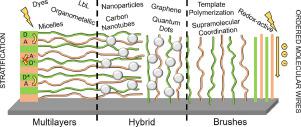Progress in Polymer Science ( IF 27.1 ) Pub Date : 2021-08-01 , DOI: 10.1016/j.progpolymsci.2021.101433 Michał Szuwarzyński 1 , Karol Wolski 2 , Tomasz Kruk 3 , Szczepan Zapotoczny 2

|
Electronic energy transfer and the migration of electrons generated via photoinduced electron transfer are key processes for the conversion of solar energy in natural photosynthetic systems. The proper arrangement of chromophores, electron donors and acceptors, or molecular wires on the scale of nanometers is a prerequisite for creating synthetic systems capable of achieving the high energy conversion efficiencies seen in nature. Ordered polymer layers that are adsorbed-to, or grafted-from, surfaces can serve as systems for harvesting of light and directional transfer of energy and electrons in confined environments. Moreover, ordered layers can act as templates for the desired ordering of different photoactive nanoobjects necessary for the development of optoelectronic devices, molecular electronics, and nanosensors. Herein, various macromolecular strategies are reviewed for synthesizing and arranging polymer chains on surfaces to improve the transport of electrons and excitation energy at interfaces. Specifically, the versatile layer-by-layer assembly method for forming thin films from polyelectrolytes and other charged nanoobjects, and the formation of surface-tethered polymer brushes, especially conjugated ones, with various chain architectures are presented together with their applications. The impact of various macromolecular architectures and compositions are discussed in relation to the performance of the polymer and polymer-templated films. Further development of the field could focus on precise engineering of macromolecules with complex architectures, precise positioning of active groups along the chains, towards mimicking the natural systems and their performance.
中文翻译:

在有序聚合物层中传输电子和激发能的大分子策略
电子能量转移和通过光致电子转移产生的电子迁移是自然光合作用系统中太阳能转化的关键过程。发色团、电子供体和受体或分子线在纳米尺度上的正确排列是创建能够实现自然界中高能量转换效率的合成系统的先决条件。吸附或接枝自表面的有序聚合物层可用作在受限环境中收集光和能量和电子的定向转移的系统。此外,有序层可以作为模板,用于光电子器件、分子电子学和纳米传感器的开发所需的不同光活性纳米物体的所需排序。在此,综述了在表面合成和排列聚合物链以改善电子传输和界面激发能的各种大分子策略。具体来说,从聚电解质和其他带电纳米物体形成薄膜的多功能逐层组装方法,以及表面系留聚合物刷的形成,尤其是具有各种链结构的共轭刷,连同它们的应用一起呈现。讨论了各种大分子结构和组成对聚合物和聚合物模板化薄膜性能的影响。该领域的进一步发展可以专注于具有复杂结构的大分子的精确工程,沿着链的活性基团的精确定位,



























 京公网安备 11010802027423号
京公网安备 11010802027423号